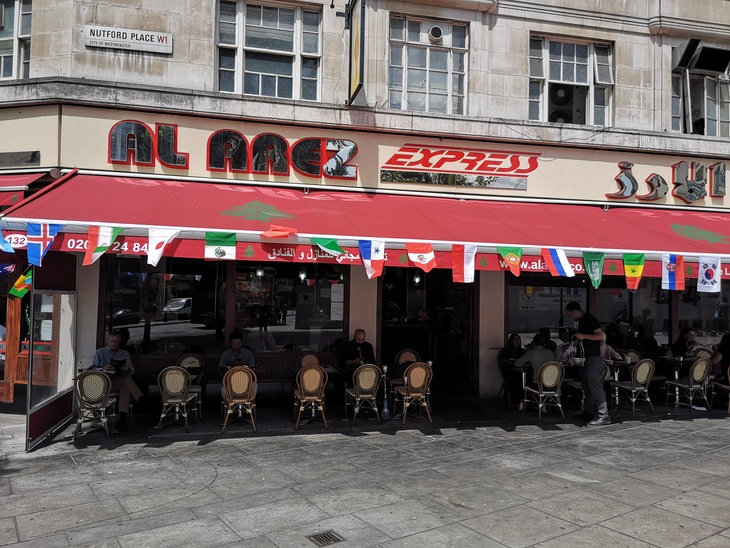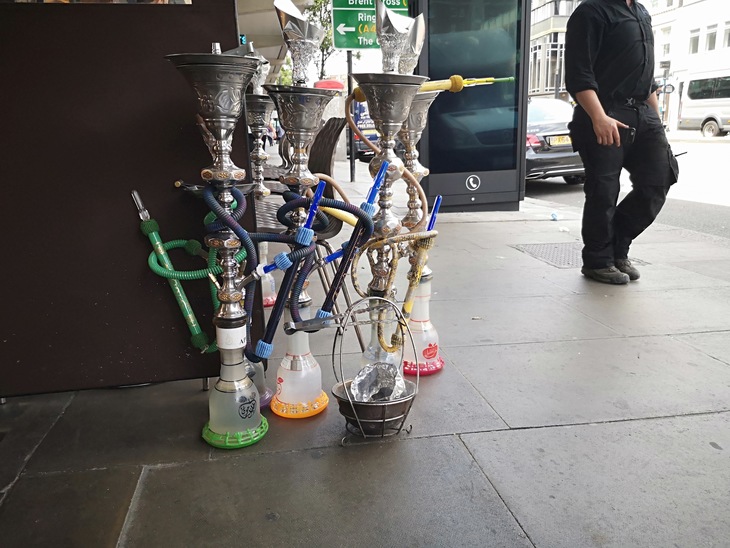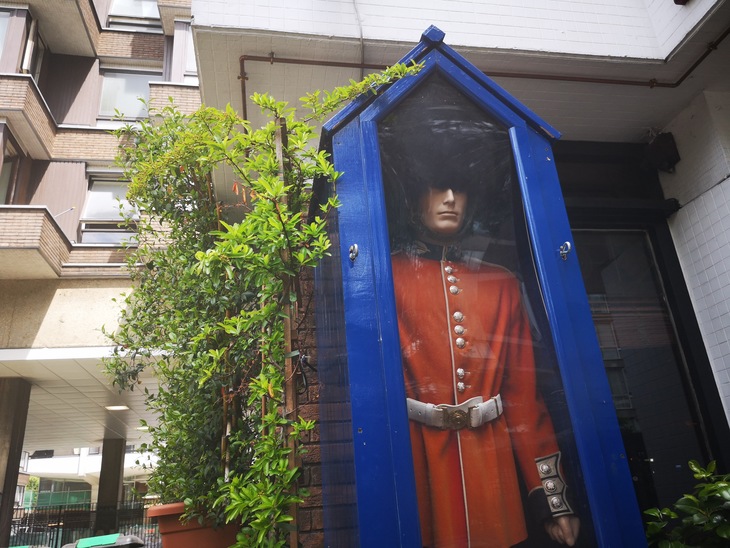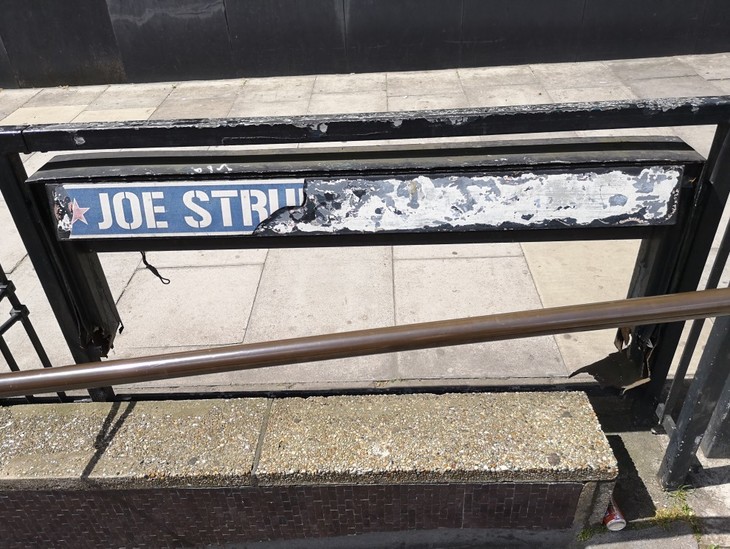
Click. Click. Click. Two men play ping pong on a table in front of the shimmering Marble Arch. This is where John Betjeman began his 1967 pilgrimage for the BBC programme, Contrasts: Marble Arch to Edgware. Although he travelled all the way to Edgware itself, we're only going as far as the end of Edgware Road 'proper'. From its southern base on Bayswater Road, to where it becomes Maida Vale. It's roasting, OK. We're not walking to Edgware.

Did you know that the arch was once a tiny police station? Well strictly speaking, it wasn't. Betjeman got that one wrong — although it was indeed manned by policemen for a time. Orphaned from its original home out the front of Buckingham Palace, the arch is now largely eschewed by tourists, in favour of the nearby Primark, which, according to our girlfriend, is the 'touristy Primark'. As if Primarks have their own personalities.
Anyway, every Londoner should take a bit of time to study this ornate, sidelined centrepiece once.

Even more overlooked is the site of the Tyburn Tree — the horrific killing contraption operated by a succession of executioners including the infamously bungling Jack Ketch. We say overlooked, but this spot has been covered by a million and one blog posts, so we shan't dwell on imagery of tree-swinging ne'er-do-wells.
These days Tyburn Tree plaque is tastefully shrouded in a miniature forest of three trees.


It is standing here, that we get an early shock. The Odeon cinema — the very same that can be seen in Betjeman's film, back then, brand spanking new — has been rubbed out. It is currently a patch of nothing, surrounded by fences plugging a set of apartments called the Bryanston. Did the marketing team who came up with this wittingly create a portmanteau of Bryan Cranston? The cinema's demolition reminds us of Betjeman's own dismay at the razing of the Metropolitan Theatre. It later became Paddington Green Police Station, more of which later.

And with that, we have truly begun our journey up Edgware Road.

At Connaught Place, a business man scurries out of one of the porticoed townhouses, clambering into the back of a black cab. Venturing just behind this road, you'd find two police personnel guarding the city home of Tony Blair (London, it seems, has still not forgiven him for Iraq). Largely though, this offshoot of Edgware Road remains tranquil and bland this afternoon. Its namesake in New Delhi is much more of a riot.
Although we're already beginning to smell a party on Edgware Road.

A line like "The sweet, apple-y aroma of shisha fills the nostrils almost the moment you hit the Edgware Road," comes across as downright trite. It's also more or less accurate. We haven't spotted the first of the ubiquitous shisha pipes yet, but the scent is already curling deliciously towards us.
We are still just about in Touristville at the southern end of Edgware Road, as evidenced by a carousel of royal postcards. But this is pretty much as far as most workaday tourists will venture.


As the Arabic script sandwich boards and estate agent windows suggest, we are now entering what came to be known as 'Little Beirut'. Arabs have descended on Edgware Road since the end of the 19th century and have long since transformed it into one of central London's most characterful thoroughfares — an infinitely more interesting pavement to pound than nearby Oxford Street or Tottenham Court Road.

We come to Nawras, an emporium peddling luxury chocolates and dates — as well as glitzy trinkets to serve them from. Behind the till, Hannane tells us that it is largely customers from the Middle East who shop here. In this heat, juices and ice cream are wheeled out the front of the shop too.


Sweets, sugar and ice cream are a repeated motto of Edgware Road — although this terrifying slack-gobbed youth does little to make you want to order a cone:

Another theme is Mo Salah: worshipped, apparently, in three places: Egypt, Liverpool and the Edgware Road. Though the Allah adverts pasted onto the sides on buses on routes along here remind people who the real god is.


While the shops along Edgware Road are by and large Middle Eastern, Hau Ren Tang — a Chinese medicine emporium which announces itself with Ming-style vases — is one of those that bucks the trend.

Edgware Road is an anomaly of independent shops peppered in with giants, rather than the other way around. So you'll find the odd Tesco and Costa Coffee rubbing shoulders rather nervously, with far more interesting outlets.

But then, why would you do that when you can order a fresh mint tea, loaded with sugar cubes, next door? We pull in at El Arez Express for the latter, and watch the clientele suck on their shisha pipes, flick through papers of various languages, and plough through carnivorous plates of kebab.
We've found one of those rare parts of London, where life is taken at a slower pace.


On the corner of El Arez, you can clock a sun-washed swinging sign: Old English Gentlemen. It's almost a clumsy metaphor for the way this road has changed. We continue up the road.

Waves of Middle Eastern residents have brought with them great colour to this part of town. Including the many independent fruit stalls and supermarkets, with their unwrapped mounds of chilies, okra and baby aubergine.


By now, we are in a cloud of shisha fumes. Pipes are sold at the roadside, like something someone may casually pick up on the way home. This time of year lends itself to long, reclined sessions on these instruments — although in the more frigid months, people are known to illegally congregate in basements beneath the road.

Two gentlemen are all to happy to pose for a photo, as they plough through cokes, fresh mango and orange pieces, and a sweet shiha pipe each.

Continuing on, it strikes us how handsome much of the architecture is along here. An art deco gem is now inhabited by a Waitrose. And to think this looks like it was once a grand theatre or cinema. We later discover it was a Woolworths. You might argue it's a classier joint than it ever was before.

Just up from it, on the other side of the road, a beautiful pawnbrokers appears to have weathered the centuries well. Earlier images online suggest it's been going since 1797.

Every now and then — partly out of curiosity, partly for shade — we nip off piste, to see what hides directly behind Edgware Road. Just off Sussex Gardens we find the unassuming Heron pub. Unassuming apart from two things: a Queens Guard, permanently Perspexed into his sentry box. And a sign that explains the pub is home to meet-ups for The Handlebar Club — a collective of gentlemen who've been priding themselves on their face furniture since 1947.

Soon after, we find this peaceful, but oddly anonymous, fenced off garden. Whose is it? What's it all about? Answers on a postcard.
The string of middling, cream-coloured hotels opposite is where, we presume, business people stay before hopping on the Heathrow Express at some ungodly hour. We wonder how many of them will still be going, after Crossrail has bedded in and the Heathrow Express meets its match.


There are two ways to approach Edgware station (which, of course, is actually two stations). The first is via the Marylebone Flyover — another structure whose cement was still drying back in 1967. "Pretty awful isn't it. A lot of people think the whole of the Edgware Road is like this," mutters Betjeman in the black and white rain.

Actually, its underbelly hints at Gothic crypt — and is currently more prettified with this street art:

Edgware Road station too (the Bakerloo one) wears makeup, in the form of a living garden wall. They've done a similar thing at Elephant and Castle.

Just to the east, lies its Circle line cousin, where Allan Sly's sculpture of a window cleaner removes his cap and scratches his head in exasperation. Why?

The behemoth of a task ahead of him. (In fact the towering building, Capital House, commissioned the wry sculpture).

Seconds later, we come to The Green Man. Could this now be the only functioning pub left on Edgware Road?

Now, if we reverse back under the flyover, and onto the opposite side of the road, here's the other way to broach the Marylebone Flyover. First we squint up the Hilton London Metropole — hard for even brutalism lovers to love. Though right now we wouldn't say no to its indoor pool.

It is time to venture into the bleakest stretch of Edgware Road. A graffiti slathered subway, with the prerequisite reek of piss and ghostly clack of footsteps.


We surface by a medley of unloved signs. One for the subway itself, named after Clash frontman Joe Strummer:

One for London's least-loved roundel.

And this slipshod sign for Paddington Green Police Station (you wouldn't have got such dire signage at the Metropolitan Theatre).

Directly after, there's a sign that harbingers change, as we enter the less-loved end of Edgware Road.

This is the poorer, grottier stretch: fewer flash estate agents and restaurants, more white goods being flogged out on the pavement. (Until the residents of West End Gate request that they're moved, of course).


There is still a great buzz of life. On Church Market, there's a great scuffle for shirts being flogged for £2 each.


Across the way, customers pick their dinners from polystyrene crates of shrimp and tilapia. This is the kind of ramshackle market that London could lose altogether.

In search of more shade, we retreat to leafy Paddington Green, which comes with the added bonus of a grass sprinkler.

Said sprinkler is aimed directly at a statue of Welsh actor, Sarah Siddons. Her humiliation is compounded by a pizza box necklace and a crisp packet tiara. Somewhere along the line she's lost her nose too.

Apt, perhaps that she was one of the 18th century's great 'tragediennes'.
Time to carry on — past more towering construction sites — as we near the end of our pilgrimage.

We stop to photograph three friendly gentlemen, who are celebrating Eid. "Do you know what Eid is?" one asks, eager to share his culture. Trump should have come here on his visit. Actually probably not.


A few doors down, we come to a barbers, ram packed with customers in the middle of the day.

Anton Avris is all too happy to pose for us, clipper in hand. His customer, understandably not. Still, you sense a great camaraderie in this place — just as you do in the Nigerian barbershops of Peckham.

And now, we reach the end of Edgware Road, as the Regent's Canal slices in at a right angle, and it becomes Maida Vale on the other side.

Suddenly the road has turned into something different. The clink of rioja glasses, as people sit out on the terrace-straddling terrace of Cafe Laville. The gentle slosh of water as boats ply the canal.

Now we are in Venice. All roads in London lead to another part of the world.

Which London road would you like us to walk up next? Tell us in the comments.




